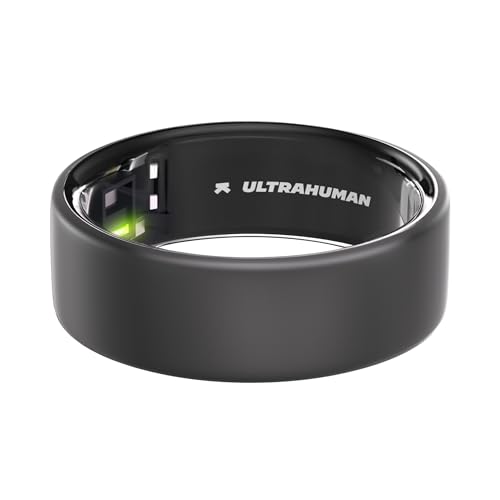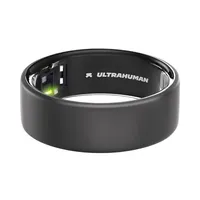Ultrahuman Ring review: Is this the best smart ring for women yet?
Smart rings are everywhere in 2024 - but could the Ultrahuman Ring be the best yet? Here, writer Katie Sims reveals all she learnt after wearing one for 3 weeks
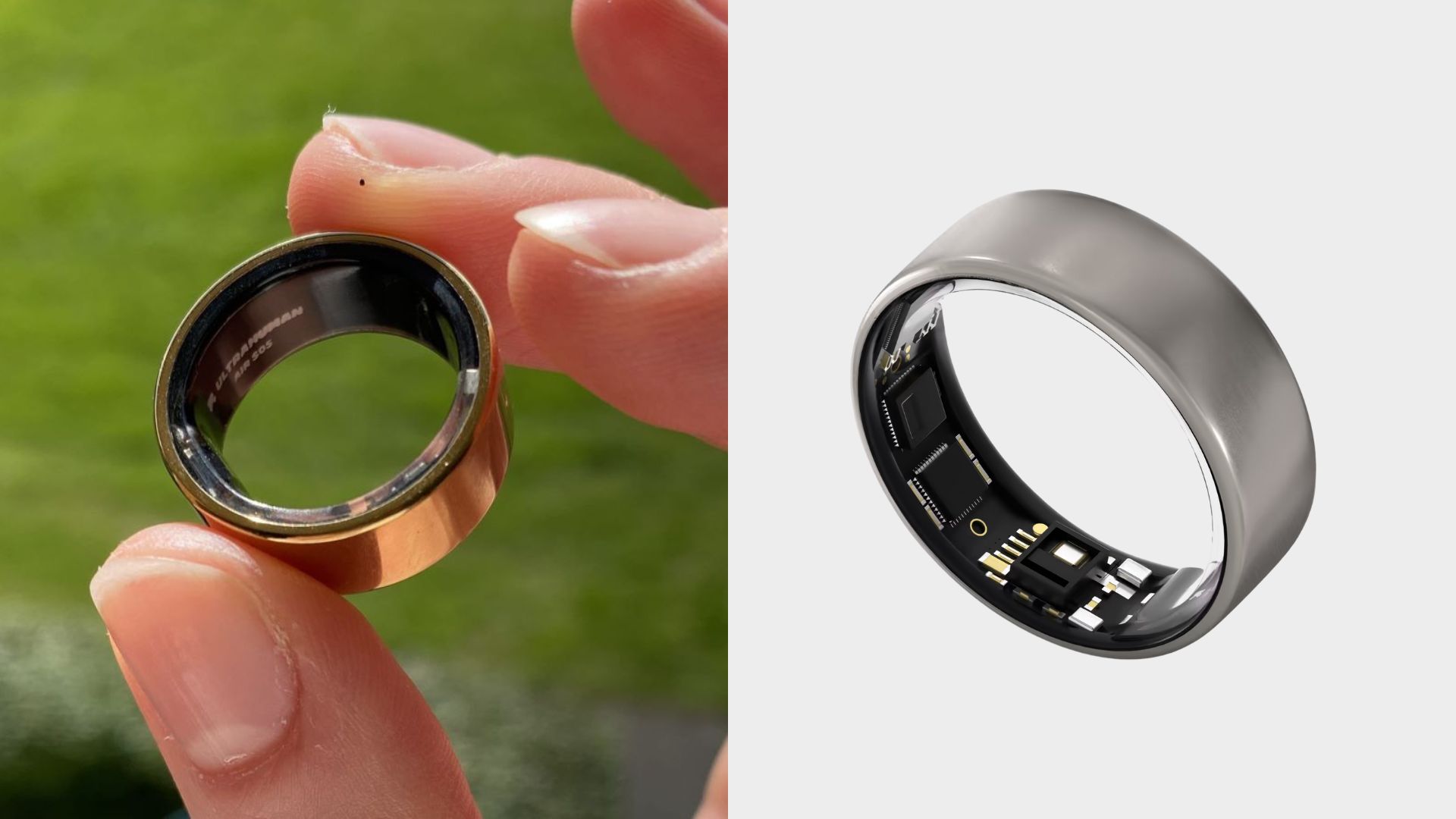
Brimming with data and insights, the Ultrahuman Ring AIR has all the benefits of Oura - but without the subscription costs
-
+
No ongoing subscription costs
-
+
Very lightweight and wearable
-
+
Provides in-depth insights into fitness, sleep and stress
-
+
Bonus plug-ins including optimal caffeine window
-
-
Can be a little confusing at first
-
-
Step tracker may not be fully accurate
Why you can trust Woman & Home

The Ultrahuman ring AIR is the latest smart ring that everyone is talking about - and it holds a lot of promise. As a subscription-free alternative to the renowned Oura ring, can it deliver the same data-driven insights to help us level up our health?
Smart rings are quickly becoming the most sought-after fitness devices on the market, and Ultrahuman is the latest brand making itself known in the field. But can this lightweight piece of tech match up to the best fitness trackers we already know and love? I had to know whether the Ultrahuman ring could be considered a worthy rival to the likes of the Oura Ring, as well as Apple, Garmin, and WHOOP devices.
When it comes to health and fitness, I try to absorb all the information I can to try and make better choices. So, a smart ring that provides personalised insights based on multiple health metrics sounded right up my street. Over the past three weeks, I've been wearing the ring while going about my daily life, in workouts, and overnight. Here's everything I discovered during the testing process, and why I'm now a firm believer in the Ultrahuman ring.
Ultrahuman Ring AIR review
Specifications
- RRP: £329
- Size: 8.1mm in width x 2.45 - 2.8mm in thickness (thickness varies depending on the size)
- Weight: 2.4 - 3.6g (varies depending on the size)
- Material: Titanium with Tungsten Carbide Carbon coating
- In-built GPS: No, must carry phone alongside for tracking
- Battery life: 6 days
- Waterproof: up to 100 metres
Ultrahuman ring AIR review: An overview
The Ultrahuman ring AIR is an innovative smart ring designed to offer personalised health insights by tracking movement, sleep, and recovery trends. In much the same way as other fitness trackers, you can record workouts and receive basic stats - such as distance, pace, predicted calories burned, workout duration and more - as well as record your sleep duration and quality, and track your stress levels.
This ring, much like the Samsung Galaxy Smart Ring, also offers advanced metrics like skin temperature readings, resting heart rate insights, and stress rhythms, which are all designed to help you understand your body better.
Despite the powerful technologies inside, the Ultrahuman ring holds the title of the world's lightest sleep-tracking device. It's available in 10 sizes and five colourways, with a sleek and discreet design that sits compactly on the finger. It's simple to charge as well with a USB-C cable, provided in the packaging.
For some, this will all call to mind competitors like the Oura Ring and the Samsung Galaxy Smart Ring. However, from subscription-less use to unique nutrition insights, this ring stands out from the bunch.
Sign up to our free daily email for the latest royal and entertainment news, interesting opinion, expert advice on styling and beauty trends, and no-nonsense guides to the health and wellness questions you want answered.
What is the Ultrahuman Ring like to wear?
There were times in the early stages of testing when I was a little confused by what all the analytics and metrics meant. When I compare using the Ultrahuman ring to my Apple Watch Series 9, I feel as though the latter was easier to understand - but with time, I found it easy to use the ring and simple to understand the metrics. If you're entirely new to fitness trackers, I'd perhaps suggest something a little more basic - like one of the best Fitbits.
In time though, I found the Ultrahuman Ring slotted into my life easily. It wasn't a hindrance to wear and I could go about my daily activities as normal. It's totally fine to wear the ring while showering, so in theory you never really need to take it off - though Ultrahuman do recommend you do this from time to time, just to give the ring (and your finger) a bit of breathing space. I did give it a quick wipe if I was using it during tasks like washing up or applying skincare as well.
The ring sends notifications to prompt you to do things - such as tapering off caffeine, going outside to maximise Vitamin D absorption, and limiting screen time to improve sleep quality. The notifications were perhaps a little frequent for my liking but I still found them to be helpful overall.
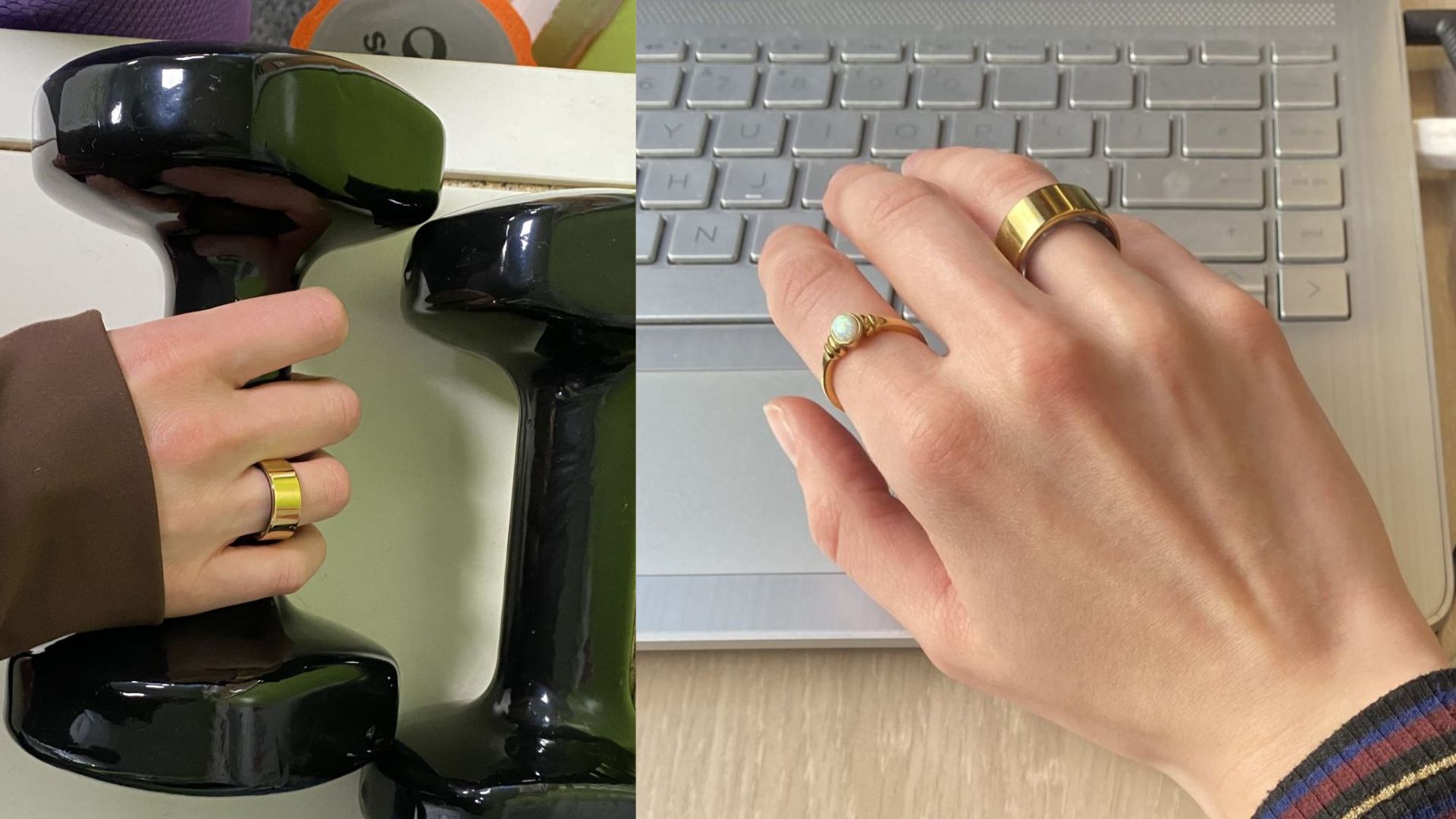
The Ultrahuman Ring is the lightest smart ring around, weighing the same as a US penny.
Fitness tracking with the Ultrahuman Ring AIR
As you'd expect for a fitness tracker, the Ultrahuman ring tracks your movement levels throughout the day. It uses this to create a Movement Index score out of 100, which resets to 100 at the start of each day and then changes in line with how much you are moving so that at the end of the day you have a numerical value of your activity. This isn't just about how many steps or the workouts you've done, but also how frequently you're moving in other ways and how many calories the device predicts you've burnt.
I found it quite easy to maintain a high score on the movement index - even when I didn't necessarily think I'd been very active on a certain day. That's because the ring favours frequent activity rather than lots of movement all at once, so my score stayed high on days when I'd been doing chores or short walks. There were times when I found this a little confusing as my movement score was lower when I went out on a long hike compared to days when I did a couple of shorter walks throughout the day. For those who do more exercise snacking than intense workouts, this could be a real benefit.
There are plenty of workout modes to log in the app and if you forget, the ring is good at tracking the movement anyway and prompting you to label it. During workouts, the ring tracks calories, heart rate, and heart rate recovery, so you have a pretty good picture of how you've performed at the end. While it's not as advanced as one of the best Garmin watches, it does a good job if you're more into daily movement rather than a specific sport. For the same reason, Garmin won out in our Garmin vs Oura Ring debate.
At the end of the day, you'll get a Dynamic Recovery Score. This combines sleep and movement data to tell you how much activity your body can endure that day, and how much rest it needs. This I found very useful for understanding how to structure my workouts and rest to get through the week with a little more energy.
The app is for more than just tracking though. In the Discover section, there's a whole host of tutorials and sessions available covering workouts, meditations, and sleep stories. Seeing as many workout apps often come with a price tag, it's good to know that when you invest in the Ultrahuman ring, you also gain access to a library of health and wellbeing resources. Though these are also available on other apps, such as Fitbit Premium, this comes at no extra cost with the Ultrahuman Ring.
The only downside I've noticed is in the step count. It would perhaps be more accurate to see it as a 'movement count'. As I wore my Apple Watch alongside the ring, I could compare stats across the two. One day, my watch told me I'd done 10,520 steps and the ring counted 12,731 steps. I believe this is because I wear the ring on my right hand and it mistakes hand movements as steps. For instance, when I brush my teeth, the step count goes up by 700+. This is something to bear in mind if you want to use the ring to track your steps accurately, especially if you'd prefer to wear it on the hand you use more in day-to-day activities. It also may become more accurate over time.
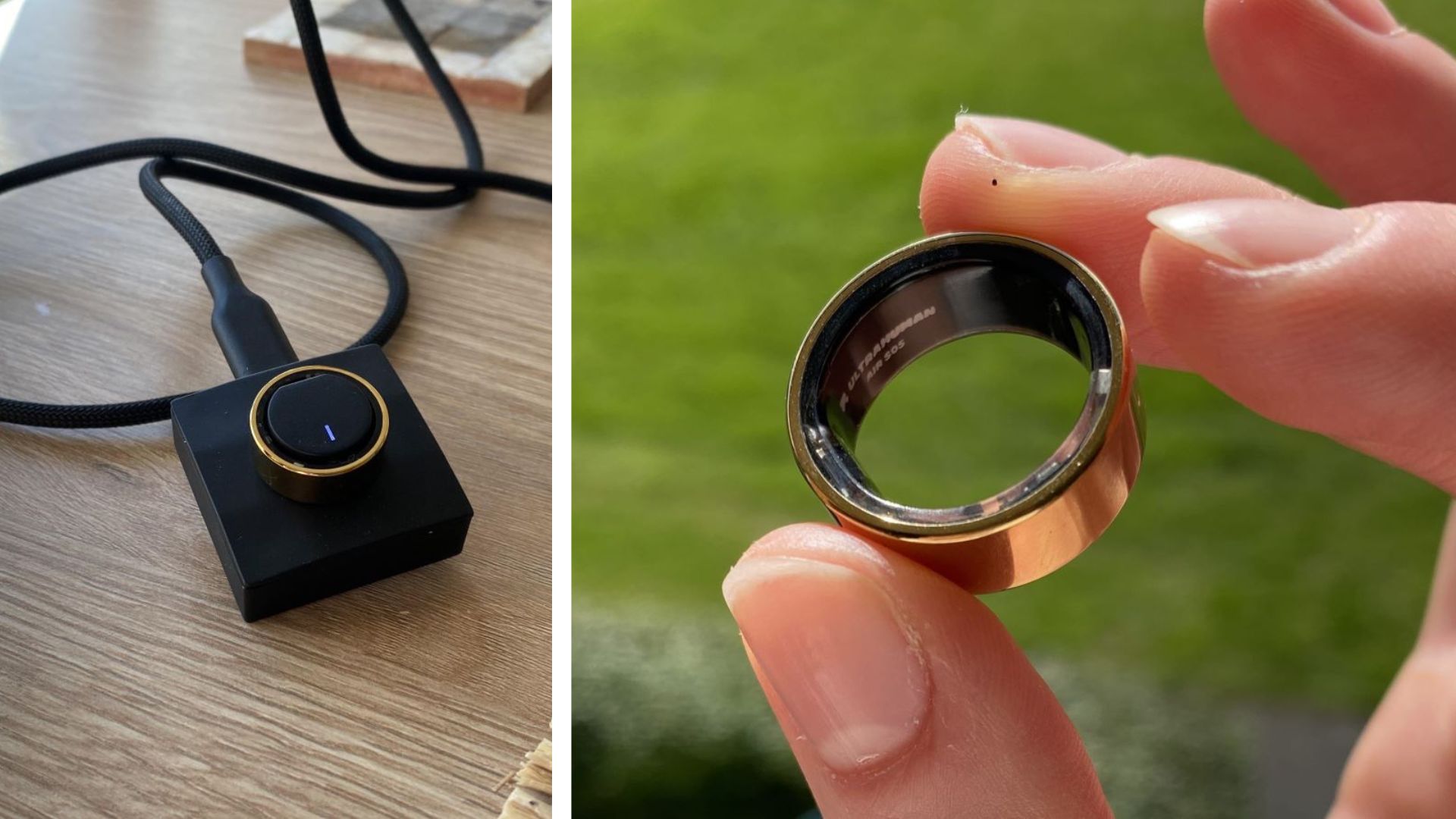
The Ultrahuman Ring is easy to charge and comes in multiple colours to suit your style.
Sleep tracking with the Ultrahuman Ring AIR
As someone who struggles with getting consistent good-quality sleep, I was really looking forward to gaining insights from the ring's Sleep Score. The score is made up of several components - including temperature, restfulness, restoration time, and heart rate drop, all of which combine to measure the overall quality of your sleep. Given that my main gripe with my Apple Watch is its lack of insights into my sleep quality, I was glad to see that the ring tacked so many different elements.
Overall, I was pretty impressed with the level of detail the ring provided. For example, the ring was monitoring deviations from my baseline skin temperature while I was sleeping, with warmer temperatures increasing my level of wakefulness and cooler temperatures increasing restfulness. This helped me figure out how to sleep better as the weather turned. In the data, I could also see when my heart rate dropped to its lowest point. The quicker the drop, the more rested I was, so this also helped me make positive changes to my routine.
Admittedly, it took a few days for me to understand all the different components that impact the sleep score, but I found the insights helpful. Based on my score, the app told me the optimal time to start winding down for sleep the next evening and how long it might take for my energy levels to start increasing throughout the day.
The only device comparable to this level of insight is the WHOOP 4.0 While another excellent fitness tracker in its own right, this one does come with a subscription you have to keep up to make use of the insights, whereas the Ultrahuman Ring comes subscription-free.
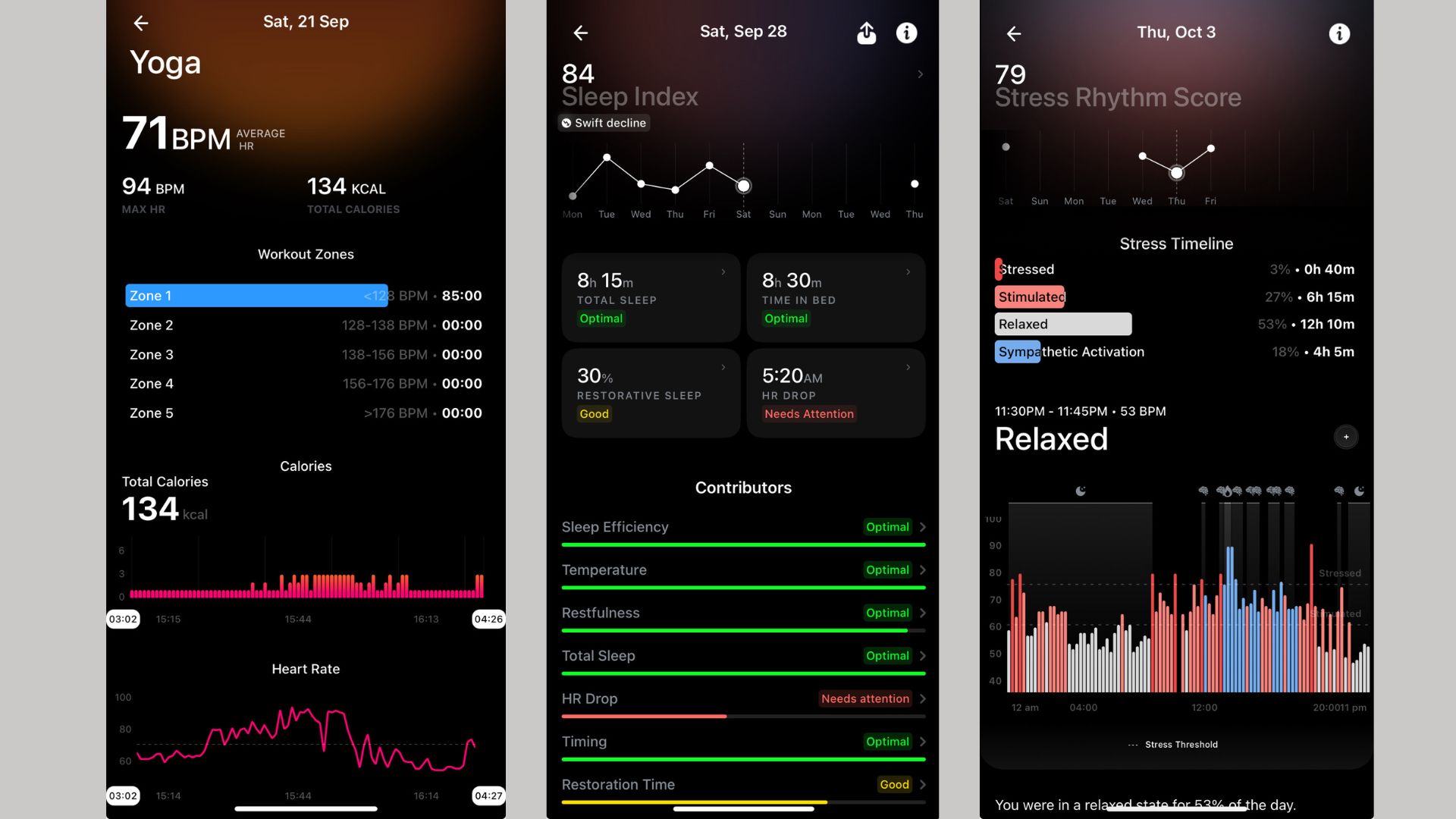
You can track multiple workouts, monitor sleep, and keep an eye on your daily stress levels through the Ultrahuman Ring app.
Stress tracking with the Ultrahuman Ring AIR
By measuring heart rate variability, resting heart rate, and heart rate, the Ultrahuman ring provides a Stress Rhythm Score, which includes a 'stress timeline' of your day, including what proportions of the day were spent in a relaxed, stimulated, and stressed state.
What I found super interesting about this was how the stress score relates to cortisol and circadian rhythm management. The ring takes into account the various circadian phases of the day - i.e. when we are more alert or when we are more likely to feel drowsy - and uses these as an indicator of how well we manage stress. I also found it to be a useful way to see when I would most likely be productive and when I should take breaks away from my desk.
The stress score is a numerical value out of 100, so at first I assumed that the higher the score, the more stressed I was. But actually, a higher score means that you are regulating stress well and in sync with the circadian rhythm. I'm always looking for natural ways to lower cortisol and manage stress better, so once I understood how the stress score worked, I found it to be a useful aid. For instance, it was interesting to see how often I moved into the 'stressed' zone after drinking a cup of coffee, and this encouraged me to start trying alternatives instead.
Personally, I got a lot from the breathwork tools in the app. There are many courses and single sessions to explore, ranging from as little as 3 minutes in length to half an hour. I particularly liked how the app prompted me to do a breathwork exercise when I moved into the 'stressed' zone. Although it wasn't always possible to down tools and start doing these, I found this helpful for monitoring my stress through the day.
Additional plug-ins
I was pretty impressed with how many additional plug-ins (called PowerPlugs on the app) that you can experiment with when using the Ultrahuman ring. One of my favourites was the caffeine permissible window, which is designed to help you track and optimise your caffeine intake. This includes the best time to consume caffeine for optimising focus and performance, as well as when to start tapering off it for a restful night's sleep. As someone who loves a cup of tea, I found it difficult to stick to the window definitively, but I did still appreciate having the information there so I could decide whether or not to act on it.
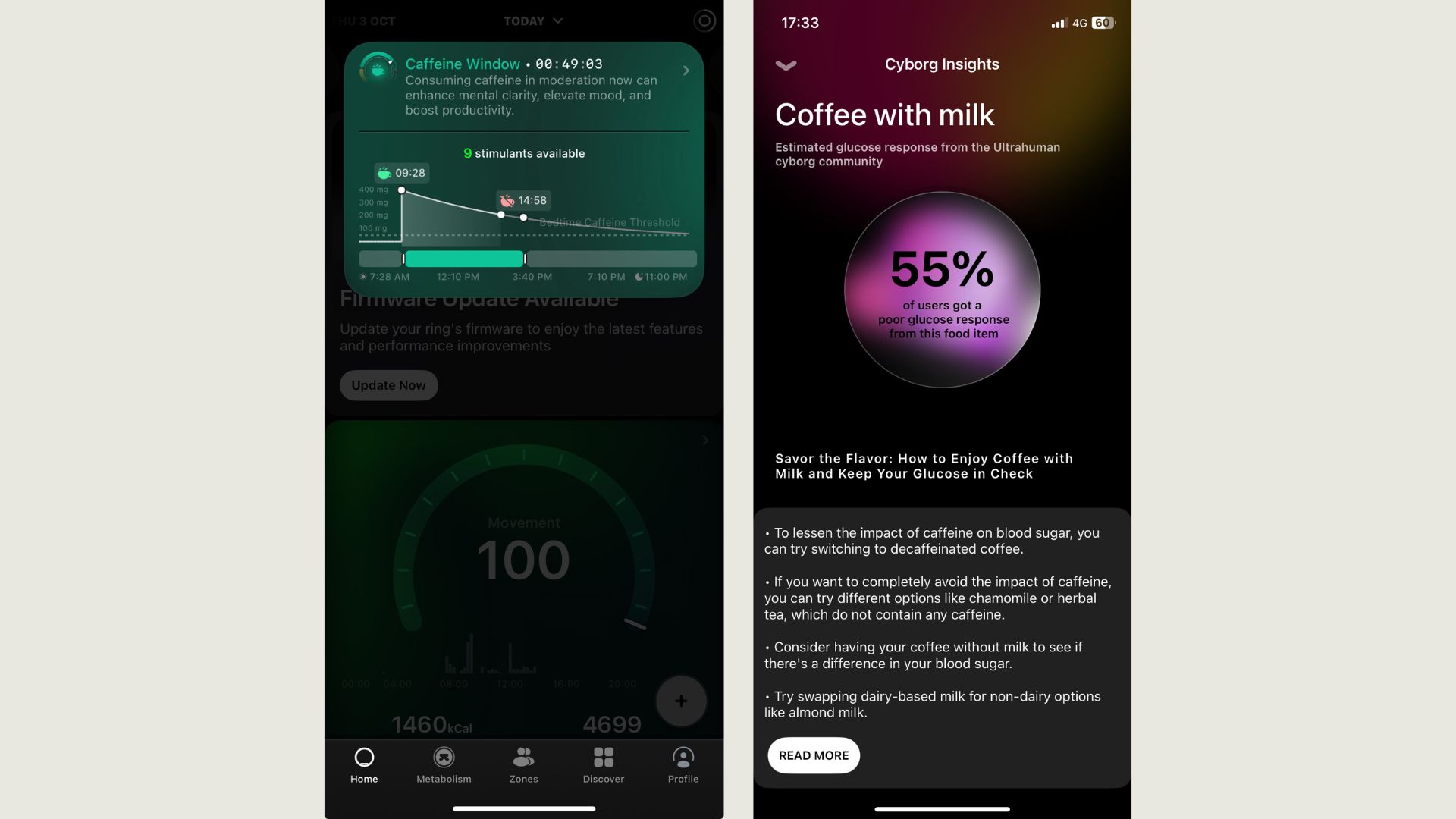
Caffeine Window is one of the unique insights available in the Ultrahuman Ring app.
I also activated the Vitamin D plug-in, which gives suggestions on the optimal time to go outside based on your skin type, location, and UV index. It then estimates how much vitamin D you've absorbed based on your time outside. think this has a lot of potential, but according to the ring I consistently maintained an 'insufficient' level of absorption, which I think had more to do with external weather conditions than the amount I was getting outside. I would be intrigued to see if this changed in the spring and summer months though.
Other plug-ins include screen time, circadian alignment, and cycle tracking - all of which can offer personalised insights for healthier habits. I see all of these add-ons as little bonuses, not offered by other smart rings or fitness trackers, and they do come in handy.
Is the Ultrahuman Ring worth buying?
Yes, if you're looking for a smart ring and primarily looking to focus on your sleep, rest, recovery, and daily movement - rather than specific sport-related goals - I'd recommend the Ultrahuman Ring.
In terms of metrics, data, and insights, the Ultrahuman and Oura Ring are pretty much on par. They both offer in-depth analysis when it comes to sleep, including how much REM and Deep Sleep you've banked, and they both offer recovery trends and recommendations. Though the Ultrahuman Ring (£329) is more expensive than the Oura Ring (£299), it is completely subscription-free so you pay slightly more money (£30) upfront but you get an experience similar to the Oura Ring but with no extra monthly cost.
I wear the ring on the ring finger of my right hand. As the instructions suggest, I would recommend trying one of the plastic rings from the sizing kit for at least a couple of days before placing an order. I ended up switching to the lowest size after trialling the next one up because I found it stayed put on my hand during daily activities.
The Ultrahuman Ring Air comes in various colourways, including black, gold, titanium, and silver. Lightweight and versatile, it's a strong contender to be the best smart ring yet.
Ultrahuman ring vs Oura ring
- Ultrahuman Ring doesn't require a subscription: The key separator between the Ultrahuman and Oura ring is that you don't need to commit to any ongoing subscription costs with Ultrahuman. When you invest in an Oura Ring, you must commit to either monthly or annual payments, whereas the Ultrahuman Ring AIR is a one-time purchase.
- Ultrahuman Ring is lighter: The Ultrahuman Ring weighs between 2.4g to 3.6g, depending on the size. The lightest weight of the Oura Ring is 4g, going up to 6g with the larger sizes. That means the heaviest Ultrahuman ring is still lighter than the lightest Oura ring. Given that ease of wear is a pretty big factor in the Oura Ring vs Apple Watch debate, this is a big green tick for the Ultrahuman ring. You'll likely forget that you're even wearing it.
- Oura Ring has a slightly better battery life: The Oura Ring has a battery life of up to 7 days after being fully charged and the Ultrahuman Ring will run out after 6. It also takes 90 minutes for the Ultrahuman ring to charge to full, compared with the Oura ring's 80 minutes. It's probably not a dealbreaker - but maybe something to consider if battery life is important to you.
- Ultrahuman Ring has caffeine window detection: One feature that the Oura Ring lacks compared to Ultrahuman is the caffeine window. Once activated, this PowerPlug will suggest the best times to consume caffeine to boost alertness without disrupting sleep - something the coffee lovers amongst us might find helpful.

Katie is an experienced digital journalist specialising in interiors and lifestyle. She started writing for Ideal Home in the spring of 2022, and since then has explored many topics related to home life, including design trends and DIYs. She started as part of the e-commerce team with a focus on shopping content, before moving on to the news team to explore all the latest happenings in the world of interiors. She's also written for Real Homes, Livingetc, Gardeningetc, and Homes & Gardens.
